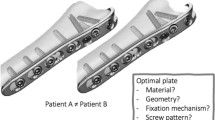Abstract
Fracture healing is a multistage repair process that involves complex, well-orchestrated steps initiated in response to tissue injury. The early upregulation of IL-6, osteoprotegerin (OPG), VEGF, and BMPs indicates a central role for these factors in the initiation of cartilage and periosteal woven bone formation. In both callus fracture repair and stress fracture repair, the RANKL/OPG ratio is initially reduced, but peaks earlier in stress fracture healing than callus fracture healing. Though the understanding of the biological processes and molecular signals that coordinate fracture repair has advanced, the cause of variability observed in fracture repair is poorly understood.
Similar content being viewed by others
References
Goldhahn J, Little D, Mitchell P, Fazzalari NL, Reid IR, Aspenberg P, Marsh D (2010) Evidence for anti-osteoporosis therapy in acute fracture situations—recommendations of a multidisciplinary workshop of the International Society for Fracture Repair. Bone 46:267–271
AI-Aql ZS, Alagl AS, Graves DT, Gerstenfeld LC, Einhorn TA (2008) Molecular mechanisms controlling bone formation during fracture healing and distraction osteogenesis. J Dent Res 87:107–118
Barth HD, Launey ME, MacDowell AA, Ager JW III, Ritchie RO (2010) On the effect of X-ray irradiation on the deformation and fracture behaviour of human cortical bone. Bone 46:1475–1485
Zarrinkalam KH, Kuliwaba JS, Martin RB, Wallwork MAB, Fazzalari NL (2005) New insights into the propagation of fatigue damage in cortical bone using confocal microscopy and chelating fluorochromes. Eur J Morph 42:81–90
Einhorn TA (1998) The cell and molecular biology of fracture healing. Clin Orthop Relat Res 335:S7–S21
Colopy SA, Benz-Dean J, Barrett JG, Sample SJ, Lu Y, Danova NA et al (2004) Response of the osteocyte syncytium adjacent to and distant from linear microcracks during adaptation to cyclic fatigue loading. Bone 35:881–891
Verborgt O, Gibson GJ, Schaffler MB (2000) Loss of osteocyte integrity in association with microdamage and bone remodeling after fatigue in vivo. J Bone Miner Res 15:60–67
Burr DB, Forwood MR, Fyhrie DP, Martin RB, Schaffler MB, Turner CH (1997) Bone microdamage and skeletal fragility in osteoporotic and stress fractures. J Bone Miner Res 12:6–15
Tsangari H, Findlay DM, Zannettino AC, Pan B, Kuliwaba JS, Fazzalari NL (2006) Evidence for reduced bone formation surface relative to bone resorption surface in female femoral fragility fracture patients. Bone 39:1226–1235
Fazzalari NL, Kuliwaba JS, Atkins GJ, Forwood MR, Findlay DM (2001) The ratio of messenger RNA levels of receptor activator of nuclear factor kappaB ligand to osteoprotegerin correlates with bone remodeling indices in normal human cancellous bone but not in osteoarthritis. J Bone Miner Res 16:1015–1027
Dimitriou R, Tsiridis E, Giannoudis PV (2005) Current concepts of molecular aspects of bone healing. Injury 36:1392–1404
Gerstenfeld LC, Alkhiary YM, Krall EA, Nicholls FH, Stapleton SN, Fitch JL et al (2006) Three-dimensional reconstruction of fracture callus morphogenesis. J Histochem Cytochem 54:1215–1228
Gerstenfeld LC, Cullinane DM, Barnes GL, Graves DT, Einhorn TA (2003) Fracture healing as a post-natal developmental process: molecular, spatial, and temporal aspects of its regulation. J Cell Biochem 88:873–884
Cho TJ, Gerstenfeld LC, Einhorn TA (2002) Differential temporal expression of members of the transforming growth factor beta superfamily during murine fracture healing. J Bone Miner Res 17:513–520
Kidd LJ, Stephens AS, Kuliwaba JS, Fazzalari NL, Wu ACK, Forwood MR (2010) Temporal pattern of gene expression and histology of stress fracture healing. Bone 46:369–378
Frost HM (1983) The regional acceleratory phenomenon: a review. Henry Ford Hosp Med J 31:3–9
Schilling T, Muller M, Minne HW, Ziegler R (1998) Influence of inflammation-mediated osteopenia on the regional acceleratory phenomenon and the systemic acceleratory phenomenon during healing of a bone defect in the rat. Calcif Tissue Int 63:160–166
Acknowledgment
The publication of the proceedings of the 5th Bone Quality Seminar 2010 has been made possible through an educational grant from Servier.
Conflicts of interest
None.
Author information
Authors and Affiliations
Corresponding author
Rights and permissions
About this article
Cite this article
Fazzalari, N.L. Bone fracture and bone fracture repair. Osteoporos Int 22, 2003–2006 (2011). https://doi.org/10.1007/s00198-011-1611-4
Published:
Issue Date:
DOI: https://doi.org/10.1007/s00198-011-1611-4




